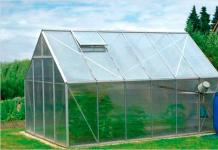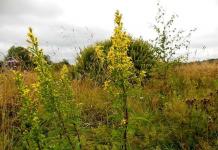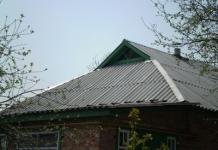Tulips are one of the most popular bulbous plants in many countries. They are frequent guests in the flower beds of personal plots, as well as clubs, broken in the middle of the city.
These flowers were originally brought from Holland. Once you have selected your tulips, planting and care must be planned.
How to choose the right bulbs for planting?
First of all, you need to remember that the bulbs should never be bought immediately before planting. In this case, there is a high probability of buying a low-quality product. The best time to buy a good bulb is late summer or early autumn.
It is important to carefully examine the bulbs, evaluate their weight, density. Outwardly, it should be intact, cracked seeds are not allowed for planting, it is not scary if their peel bursts. The color of the peel should have a light appearance, a smooth surface, no inclusions, as well as local darkening.

Usually a dark color means that the bulb has not been stored properly or is infected. This is confirmed by various spots on the surface. You do not need to choose such seeds, they simply may not sprout, or they will infect the rest. Each of them should be dense and heavy enough. The light weight means that the contents are likely to have rotted.
You should also pay attention to the bulbous bottoms, they should have several small tubercles, their color is light brown, dense. Soft bottoms are the result of improper storage and further non-viability of the plant. As well as sprouting roots.
Do not buy the following bulbs:
- cracked;
- With the smell of rot;
- Soft texture.
Choosing a place to land
Of great importance is planting tulips in open ground and caring for them. It is necessary to carefully select the soil for planting. It is better to choose a place that is free enough, do not plant tall plants nearby that will unnecessarily obscure the flowers.

For better planting and caring for tulips, you should choose fertile soil, well saturated with fertilizers. Do not plant in dense clay soils, as the plant will take root worse and will not produce luxurious flowers. The best fertilizer options that are used for planting and caring for tulips:
- Lime fillers;
- Peat additives;
- Humus.
Fresh manure should never be used for care, it can destroy flowers.
Humidity should be chosen average, with high soil moisture there is a possibility that the plant may rot or an infection will join it. With little access to moisture, you need to carefully monitor the flowers, water them more often. If this is done rarely, then the plant may dry out.

Basic soil requirements:
- good illumination,
- high fertility,
- Light and fluffy
- Protected from pathogens of tulips.
The landing site must be carefully prepared in advance. If you want to grow beautiful flowers, then you need to choose the most fertile place for this. Well, if vegetables grew in front of the tulips at the landing site, you should avoid the soil in which the bulbs grew. They can become a source of disease.
Rules for planting bulbs
Before planting, the earth must be carefully dug up. Bulbs should be planted at different depths, it will depend on the size of the bulbs, as well as on what kind of soil you plant flowers in.
Flowers do not need to be deepened into dense soil, as they will sprout worse. In addition, do not pre-moisten it before planting.

The bulbs are lowered into dry ground, they should not be pressed down strongly, as the root system may be disturbed. You just need to put them on the surface. The earth just needs to be sprinkled.
The optimal distance between flowers is at least 10 cm, for greater protection from the wind, you need to plant no further than 20-30 cm from each other. Planting and caring for tulips will take less effort.
What is the best time to plant flowers.
For the care and planting of tulips, it is necessary to strictly choose the optimal time.
Autumn is the best time to plant bulbs. In the middle lane, they try to plant bulbs before the onset of frost. In the southern regions, the time frame is shifted before the onset of cold weather.
If the autumn is warm, then you need to wait a bit. If you plant the bulbs in warm weather, they can begin to germinate, and therefore the flowers will die in frost.
Before planting, the bulbs must be treated with potassium permanganate to destroy the infection.
Bulbs should be kept in moderate cold during the winter so that the bulbs accumulate various nutrients that will help ensure good growth and long flowering.
When planting a plant in the spring, you may not get flowering that year. Since the plant does not have time to take root. Usually buying plants in the spring they do not contain nutrient reserves in the bulb.

Requirements for digging bulbs:
- For special varieties, this should be done every two to three years;
- After flowering, you must first cut the stem, and dig it out after a few days;
- After removing from the ground, the bulb must be thoroughly cleaned;
- After thorough drying, process in a solution of potassium permanganate.
Basic requirements for caring for tulips
Planting and caring for tulips is kept under constant control. These flowers are quite unpretentious. Shoots appear early, after the snow melts and the sun begins to warm the earth. If you covered the bulbs after planting, then at the first appearance of heat, you need to remove everything. The earth is worth keeping postcards.
After the emergence of seedlings, they must be carefully examined. Do not leave diseased plants in the ground. As well as those that began to grow incorrectly. Many of them will produce crooked stems and empty buds.

They need to be treated regularly for pests. Tulips are very susceptible to various diseases.
Careful control of soil moisture also plays an important role in care. Before flowering, soil drought should be prevented, it should be constantly moistened.
The earth should be constantly loose, rocky soil should not be allowed.
Tulip is a perennial herbaceous bulbous plant of the Liliaceae family, which has earned an enviable popularity in the world of breeding and horticulture in its history and occupies a prominent place in the list of the most popular ornamental plants.
Story
The homeland of the tulip is Türkiye. In the middle of the 16th century, despite all the export restrictions, the flower was transported to the capital of Austria, and then to Holland. English, French, German merchants are fond of growing tulips. In those distant times, they are grown in the gardens of only noble and wealthy people. In Russia, these flowers appear during the time of Peter I.
Symbolism
Many beautiful legends and symbolic meanings are associated with tulips. Gentle and touching, they symbolize love, joy, happiness. The time of flowering tulips is associated with the arrival of spring, holidays and good mood.
Description
The plant admires the variety of varieties. The color of the flowers is striking in its color. They can be of the same color (white, yellow, red, purple, etc.), or they can combine several different shades.
The shape of the flower is bell-shaped, goblet-shaped, cup-shaped, in the form of a lily.
Goblet Cupped Oval Parrot Lilyflowered  Double Fringed Flower Forms
Double Fringed Flower Forms
According to the terms, the varieties are divided into two types:
- Early flowering;
- Late flowering.
The beginning of the point of growth is a bulb, from which a straight stem appears with several leaves and one flower. The fruit is a trihedral box with triangular, flat, brown seeds.
Tulips grow well in full sun. An important condition is protection from the wind. In such places, tulips look healthier, brighter, bloom earlier.
Tulips are grown in group plantings of one or more varieties. Tulips prefer light, loose, rich, moderately moist soils. An important condition for growing are "clean beds", freed from weeds.
Landing
The bulbs are planted in the fall, when the period of natural biological dormancy ends in tulips. Only healthy bulbs are used for planting. Choose a time before the soil freezes, otherwise the bulbs may not have time to take root.
The landing pattern can be very different. Planting density is maintained up to 15-20 cm, depth up to 10-15 cm. Prepared holes or grooves are carefully watered and the bulbs are laid out in them with the bottom down. They fall asleep with earth, a layer of 5-10 cm.
Tulips tolerate winter well. During winters with little snow and low temperatures, plantings are covered with insulating organic material - peat, humus, leaves.
Care
Growing tulips is easy. These are hardy plants that require little care. Start care in the spring. After the snow cover has melted, the plantings are carefully loosened, with dry soil, regular, moderate watering is carried out. Tulips love moisture.
During the growth period of the tulip, three top dressings are carried out using solutions of organic and mineral fertilizers:
- The first is carried out after the emergence of shoots;
- The second - during budding;
- The third - after flowering.
Regularly carry out weeding and loosening. Blooming tulips are not cut off, but broken off, leaving as many leaves as possible. After flowering, watering is reduced, wilted flowers are removed so that the plant does not waste energy on seed ripening. After yellowing and wilting of the leaves, the bulbs are dug up. So that the bulbs do not shrink, the digging procedure is repeated every season.
Before storage, the bulbs are disinfected in a four percent solution of karbofos to prevent diseases and protect against pests. Then dry in the shade, in the open air, for a week.

Before storage, the bulbs are sorted, selecting large and medium sizes. Children are separated at the same time. Storage areas should have low ambient light and good ventilation.
The storage temperature should be around 17-20 degrees C. In such conditions, the bulbs are stored until planting in open ground.
reproduction
You can propagate tulips:
- seeds;
- With the help of bulbs.
Seed propagation is used more often by breeders. Reproduction with bulbs is faster and more efficient. For these purposes, bulbs with a diameter of at least 12 cm are selected. It is believed that these are the ones that inherit the main varietal characteristics. Smaller bulbs need to be grown at home before planting in open ground.
Diseases and pests
Tulips can be affected by viral diseases. One of these is variegation, which is manifested by the presence of spots, strokes, stripes on leaves and flower petals. It is very difficult to deal with such diseases. It is important to observe disinfection measures, and if the plant is damaged, it is better to destroy it.

Fungal diseases may occur. These include various rots:
- Root;
- Gray;
- White;
- soft;
- wet;
- Tobacco necrosis virus, known as "August disease".
Plants affected by these diseases are also best removed, and the planting site and neighboring plants are disinfected with antifungal drugs. Ash treatment can be applied.
To protect against pests (bears, scoops, slugs), traps are placed and hung. Against rodents, the bulbs are sprayed with iron minium and mousetraps are placed.
Tulips are very popular flowers, today we will talk about planting and caring for them in the open field. Their beauty has won the hearts of many people. Modest flowers adorn not only household plots, but also city flower beds. Fashion for tulips came to us from Holland. Magnificent flowers do not cease to delight with their beauty and rich palette of colors for many years. They began to grow tulips in Persia. Then they learned about their existence in Turkey and Europe. The name of the flower comes from the oriental headdress "turban". In Turkey, this graceful flower is usually worn in a turban.
The tulip is a member of the Liliaceae family. There are many garden varieties of these beautiful flowers. The height of the plant depends on the variety. The size of miniature species does not exceed 20 cm. There are tulips 70 cm high.
Bell-shaped flowers come in a variety of colors. Tulip petals are both simple and double. And now more about
Growing tulips outdoors
Choosing bulbs for planting
It is advisable to buy tulip bulbs before the start of the planting season. The most suitable time for this is the end of July - mid-September, when they are at rest. During the planting season, it will be very difficult to acquire high-quality planting material. In the spring, as a rule, they sell old bulbs that they did not have time to sell last season.
Preference should be given to bulbs with a thin golden skin. Cracks on them should not scare you. The main thing is that the bulb itself is not damaged, since the planting material is easily injured.
A thick, dense bulb with dark brown scales indicates that it is not suitable for planting, it will be very difficult for the roots to germinate.
If it is not possible to immediately plant flowers, tulip bulbs are cleaned in a cool room. They are stored separately from other bulbs. If sick bulbs are caught, they will infect healthy ones.
As for the size, it is better to take young, healthy, medium-sized bulbs. They should look good. On a bulb unsuitable for planting, there will be mechanical damage, mold spots, and dried pulp.
The surface of the bulb should be dense and clean. It will not be superfluous to take the bulb in your hand. A small weight indicates illness. A healthy bulb feels heavy to the touch.
When buying, you need to inspect the bottom of the bulb. Root tubercles are visible on quality bulbs. You should not buy planting material with a soft bottom, rotten or sprouted roots.
When should tulips be planted? Landing times and dates
Central Asia is the birthplace of almost all varieties of tulips. In their natural environment, they grow in the steppes, deserts, foothills, in mountainous arid regions. In early spring they form bright flowering carpets. With the onset of heat, beautiful tulips fade. But the bulbs continue to exist, deepening into the ground. In autumn, new roots appear on them. In the spring, waking up from their winter sleep, tulips bloom again, delighting us with their beauty. 
In nature, tulips bloom only after winter cooling. During this time, they accumulate special nutrients that help them germinate.
Planting tulips in autumn
Experienced flower growers plant tulips only in autumn. Planting time depends on the region where flowers are grown and climatic conditions.
In the conditions of the middle lane, tulips are best planted at the end of September.
In the southern regions, this has been done since the beginning of October, when the thermometer drops to 7-10 ° C. The root system of bulbs is formed 3-4 weeks. Keep in mind that the weather can make adjustments.
With early planting, the rooting process is delayed, the bulbs can become ill with Fusarium. In addition, in warm weather, the bed can become overgrown with weeds that will take strength from the tulips.
Too late to plant flowers is also not recommended. Due to frost, the root system may not form. They may rot or freeze. Usually such tulips do not bloom well, their bulbs are not suitable for further planting. 
If the bulbs were planted in November, they are covered for the winter with spruce branches or foliage.
Planting tulips in spring
Spring is an unfavorable time for planting tulips. Flowers, of course, will grow, but will bloom later. To speed up flowering before planting, the bulbs are placed in the refrigerator overnight.
After cooling, they are washed with a weak solution of potassium permanganate and planted in open ground. This must be done before April. If frosts still occur in your area at this time, the bulbs are first planted in containers, and then carefully transplanted into a flower bed.
Site selection and site preparation for tulips
- Tulips will be most comfortable in a well-lit place.
- Graceful flowers cannot stand drafts, so they must be protected from strong winds.
- They are suitable for areas with a flat surface that are protected from groundwater.
- For normal growth and development, flowers need a thick fertile layer of earth.
- They like loose soils with neutral to moderate acidity.
When choosing a place to plant, it is worth considering which plant was grown here before. Vegetable crops and flowers are considered good predecessors. In order to avoid infection with viral diseases, they cannot be planted in place of nightshade and bulbous. 
The growth of tulips largely depends on the choice of soil. It should be loose, fertile, well pass moisture and air. Loamy soils and sandy loam rich in humus are most suitable for them. Other soils can be enriched by applying certain fertilizers.
Sandy lands dry out quickly and contain few nutrients. To eliminate these shortcomings, tulips will have to be watered more often and fed with mineral fertilizers.
With heavy clay soils it will be more difficult. In order for them to become suitable for tulips, coarse river sand, peat, and rotted manure are added to them. This will help increase the permeability of the soil. When using peat, its increased acidity is neutralized with chalk or lime. During the period of intensive growth, heavy soils should be loosened more often.
In the spring, at the place of the future planting of tulips, slowly decomposing organic fertilizers should be applied to the soil. Mature manure or compost works well.
planting tulips
Only healthy and high-quality bulbs are suitable for cultivation. Before planting, all bulbs must be carefully inspected in order to identify infected material in time.
If you are going to plant bulbs that you have grown on your own, they must be pickled in a 0.5% solution of potassium permanganate for 30 minutes. Planting material purchased from a specialized store or garden center is fully prepared for planting.
For planting tulips, it is necessary to prepare beds 1-1.2 meters wide with longitudinal or transverse furrows. The length of the ridge can be any size. 
Prepared bulbs are gently pressed into the bottom of the furrow, so as not to damage the root system, they are covered with earth.
Planting depth depends on bulb size and soil type.
On light soils, tulips are planted deeper than on heavy soils. A distance of 20 cm is kept between rows. Bulbs are planted every 9-10 cm.
Many flower growers plant tulips with a tube. To do this, take a metal tube 5 cm in diameter with a piston that can be fixed. Having chosen a column of earth of the desired depth, the bulb is lowered into the hole, and the earth is pushed out with a piston. This method has many advantages. Properly planted bulbs will be protected from damage, and your hands will not freeze.
Plastic baskets are also used for planting tulips.. This method is simple. The bulbs are carefully laid out along the bottom of the basket, the container is placed in the prepared recess and sprinkled with earth. Flower bulbs will not be able to get lost in the ground. At any time they can be dug up. 
When mass planting tulips in the prepared area, a layer of soil 10-15 cm thick is removed, the bulbs are laid out and sprinkled with earth. With this planting method, you can make a floral pattern using tulips of different colors.
Video about planting tulips
Tulip Care Rules
Despite the fact that tulips are unpretentious plants that are resistant to various diseases, improper care of these modest flowers can lead to rotting of the bulbs, stem deformation and the appearance of blind buds.
Well-prepared land makes it much easier to care for flowers.
As a rule, tulips come out from under the snow in late March - early April. If you covered the flowers for the winter, the mulch is removed immediately when the snow melts. The earth will warm up faster, and tulips will bloom earlier.
When the first sprouts of flowers appear, they should be well examined in order to identify defective and diseased bulbs. To prevent the disease from spreading to healthy tulips, bad bulbs are dug up and destroyed. 
To increase the access of oxygen to the roots, the ground around the sprouts must be carefully loosened. This procedure is carried out throughout the entire period of intensive growth of tulips. It is especially important to loosen the soil after watering.
Tulips need moderate watering before flowering. Overdrying of the top layer of the earth should be avoided.
Fertilizing tulips with fertilizers:
- When the sprouts appear from the ground, they must be fed with nitrogenous fertilizers so that the foliage grows.
- The second top dressing is carried out when several leaves of the tulip unfold. This time you need to use complex mineral fertilizers.
- During the formation of buds, flowers really need phosphorus and potassium.
- The last time complex mineral fertilizers are applied when the buds open.
When fertilizing, precautions should be taken so that the flowers do not get burned. Fertilizers are applied in cloudy weather or during irrigation.
During flowering, watering tulips should be plentiful, water them only with warm water. In order for them to develop well, they should be fed with phosphorus-potassium fertilizers. Bulb development is facilitated by manganese, zinc and boron.
During flowering, tulips are also inspected, digging up diseased specimens. 
Tulips bloom very quickly. After wilting, the flowers are watered for another 2-3 weeks. Inflorescences that have faded must be pinched off so that the plant does not waste energy on the formation of seeds.
When to dig up tulips?
Ordinary red varieties usually grow in one place for several years without digging and transplanting. But varietal tulips, in order to preserve decorativeness, need to be dug up. Otherwise, they will go deep into the ground, and the flowers will become smaller.
At the end of mid-June, when the leaves wither halfway and become soft, you can start digging.
After removing from the ground, the bulbs are cleaned, dried in the shade. Then they are placed in boxes or boxes in a thin layer and left until autumn in a room with a temperature of about 20 ° C. It must be well ventilated.
It is necessary to sort out and check the bulbs during storage - remove the diseased and rotten ones immediately.
Video about digging and storing bulbs
Reproduction of tulips
Tulips can be propagated by seeds and babies.
The seed method is very long - this is a job for professionals and for breeding new varieties. Seeds are sown in boxes and grown for 3 years in one place, then planted on a separate bed for growing. And they keep growing for a few more years. The first flowering may be 5-6 years after sowing. And they become truly decorative after 10 years.
And at the same time, the varietal characteristics of the parents are not inherited. So tulips are cross-pollinated flowers.
It is easier and faster to grow tulips from babies. Moreover, the children retain the varietal characteristics of the parent onion. 
To quickly form small onions, you need to cut the flower during flowering. Then, at the usual time, we dig out the bulb, after the leaves have withered.
Small onions are separated and planted in autumn in a separate bed. Sheltered for the winter. Grow them for two or three years, pluck the flowers. Let them grow a good full-fledged bulb before flowering.
Every summer they dig up, like adult flowering bulbs.
Mouse Protection
Mice love to feast on bulbs left in the ground. To protect the flowers from rodents, it is necessary to plant daffodils and hazel grouse in the area next to the tulips. The bulbs of these plants are poisonous to mice. Also, pests cannot stand flower beds with cynoglossum.
You can take care of the safety of the bulbs in advance by carefully treating them with a spray bottle before planting with kerosene or Vishnevsky ointment. Mice are also repelled by the smell of red ground pepper. In the fight against rodents, you can use granular poison. It is buried next to beautiful tulips.
Plant tulips with pleasure in your plots - now planting and caring for them will not make it difficult for you!
As soon as the cold leaves and warm spring days come, tulips begin to bloom in the yards and gardens, planting and caring for them in the open field is simple and understandable. These flowers are rather unpretentious, but only if you want unusual and large buds to please your eyes, you need to properly care. If you decide to opt for one of the types of tulips, then if you follow all the rules necessary for caring for them, you can achieve their annual bright and unusual flowering.
Description of spring flowers
 Tulip (lat. Tulipa) is a perennial bulbous plant belonging to the Liliaceae family. It is popular with gardeners who grow them in home gardens, as well as with professionals involved in breeding an unusual flower in large quantities. There was a tulip from Central Asia. This name is due to its shape, reminiscent of a Persian turban.
Tulip (lat. Tulipa) is a perennial bulbous plant belonging to the Liliaceae family. It is popular with gardeners who grow them in home gardens, as well as with professionals involved in breeding an unusual flower in large quantities. There was a tulip from Central Asia. This name is due to its shape, reminiscent of a Persian turban.
You can meet a plant in nature in the steppe, desert, foothills and in mountainous regions with an arid climate. With the onset of warm days, you can enjoy colorful carpets of blooming tulips. As soon as the heat comes, flowering ends, but the bulbs do not disappear, but go deep into the soil. After the onset of autumn, young bulbs begin to form on the bulbs.
Myth or truth: black tulip
The most successful species that has been created is the black tulip. Haarlem tulips first appeared in the middle of the 17th century and had a deep purple color.

Black Tulip
Dane Gert Hagemann was able to breed a completely black tulip for the first time only in February 1986. This is exactly what the director of the Institute of Floristry of the Netherlands told at a press conference.
In order for a rich black tulip to appear in the world of floristry, about 400 thousand dollars and a long 300 years were spent on the experiment.
The numerous varieties of tulips bred, of course, have a more extensive palette of colors. You can find purple, purple, black, red, as well as varieties whose flowers include several colors that perfectly harmonize with each other.
If we consider the varieties according to the shape of the flower, then you can find: cup-shaped, goblet-shaped, lily-shaped, peony-shaped, oval, star-shaped and fringed tulips.
Which bulb to choose when buying
Buy bulbs should be before the planting season. It is worth doing this from the end of July to mid-September. The fact is that it is at this time that the tulip bulbs are at rest. In the spring, you run the risk of buying old planting material, which could not be sold last year. In the fall, finding high-quality bulbs is also not easy, as they are quickly sold out by flower growers.

Consider the main criteria by which you can determine whether the bulb is worth it or not.

If you have a clean, dense bulb in your hands, not empty inside, then it is definitely worth buying, as these are indicators of the best bulb material.
Also pay attention to the bottom of the bulb, in this place root tubercles should already be visible. If the bottom is soft, rotten or with existing roots, then you should not buy it either.
Proper planting of tulips in the fall in the suburbs
Professionals are planting tulips in autumn in the Urals. When exactly it is worth planting depends only on which region you live in, as well as what climate prevails in it.
So, when and how to plant tulips
- If you live in the middle lane, then planting should be done in the last days of September.
- In the event that the region is southern, then the bulbs should be planted in early October, if the temperature does not exceed 7-10 degrees.

How they bloom
Roots will form in about 3-4 weeks, but the weather plays a significant role, which can speed up or slow down this process. Therefore, weather conditions affect when to plant tulip bulbs.
If the bulbs are planted ahead of schedule, rooting will be more difficult or the planting material will be affected by Fusarium. Weeds that appear during warm weather can also cause a problem, because it is they who take all the strength from future tulips.
When you have to plant tulips at a later time, the process may not bring the desired results. Frosts can hit the root system that has not had time to form, which will lead to rotting and death of the bulb. If the plant managed to survive, then bloom and grow, it will be much worse than those tulips that were planted in accordance with all the rules.
Bulbs planted in November should definitely be covered with spruce branches or foliage, which will provide them with a decent winter.
Is it possible to plant tulips in the spring in the garden
Proper planting of tulips in the spring in the Moscow region requires special preparation that will help them take root better. And the main problem will be how to plant tulips in spring so that they bloom.
Remember that you can grow beautiful and strong flowers only from healthy planting materials.
How to choose a place and prepare it 
- Tulips do best in areas that receive direct sunlight.
- Shield them from strong gusty winds.
- The site chosen should be level and without groundwater when it comes time to plant the tulips outdoors.
- In order for tulips to grow and develop perfectly, they need a good layer of fertile soil.
- The acidity of loose soil should be moderate and neutral.
Pay attention to what crops grew in your chosen place earlier.
Areas where flowers and vegetables were grown are suitable for planting tulips.
If nightshade and bulbous crops grew in the chosen place, then there is a risk of infection with viral diseases.
What should be the soil
From what land you plant tulips in, it will come from how healthy and beautiful they will grow. For planting, loose, nutrient-rich soil is suitable, which perfectly passes oxygen and air. Tulips will feel good in loamy soils and sandy loam, which are saturated with humus.

The best place where a tulip will land is considered to be land endowed with the following properties:
- It contains quite a large amount of humus.
- It is endowed with a neutral reaction of the environment.
- The site is treated with the necessary preparations that increase its fertility.
If the soil contains a lot of sand, then the moisture in it will not linger for a long time, which means that you will have to water the flowers much more often.

Blooming double tulips
Also, in such areas, as a rule, there are practically no nutrients, so the plant will need frequent fertilizing with mineral fertilizers.
If the ground is heavy and contains a lot of clay, then fixing it will be much more difficult than with sandy soil. Before proceeding with the planting of tulips, it is necessary to bring river sand, peat and rotted manure into such a land. Thanks to these components, the earth will conduct moisture much better, and you will avoid stagnant water.
To reduce acidity, you will need chalk or lime. At the moment when the plant is actively growing, the soil must be loosened regularly.
In those areas where tulips will soon be planted, it is necessary to apply organic fertilizers, which can be both rotted manure and compost.
Tulips: planting and care in the open field
In order to grow beautiful flowers, you need to purchase healthy bulbs. Before embarking on planting, be sure to inspect the planting raw materials, which will allow you to identify any disease in advance.

- In the event that the bulbs were grown at home, and not bought in special stores, then place them for half an hour in a 0.5% solution of potassium permanganate. Purchased bulbs do not need to be soaked.
- The width of the beds for planting plants should be at least 1-1.2 meters. The furrows where the bulbs will be placed can be both longitudinal and transverse. It doesn't matter what the length of the bed will be.
- Bulbs ready for planting must be carefully pressed into the bottom of the hole. Be extremely careful not to damage the roots. After all the planting material is in the groove, cover it with soil.
- The depth to which the bulbs should be planted depends only on the size of the bulbs you have purchased and what soil they are planted in.
- If the soil is light, then planting tulips should be a little deeper than in heavy soil. The distance between the rows should be at least 20 cm. Place the bulbs in the holes, you need to retreat 10 cm between them.

bicolor tulips
Most gardeners use a metal pipe with a diameter of 5 cm to plant tulip bulbs. It must have a piston that can be fixed. Thanks to this piston, you will be able to push the bulb into the ground. Using this method, you will be able to plant the bulbs at the desired depth, and also protect your hands from the cold.
Another method used for planting bulbs is the use of plastic baskets. Quite a simple and easy way, with which you will never lose the place in which you landed tulips. All that needs to be done is to place the planting material in a basket, which is placed in a place prepared for planting and buried in the ground.
The first tulips break through the soil in late March or early April. In the event that the flowers were covered before the onset of cold weather, then as soon as the snow melts, the mulch should be removed. This will allow the soil to warm up much faster, which means that flowering will begin earlier.
Carefully loosen the soil next to the plants to oxygenate the root system. While the tulips are actively growing and developing, this procedure should be carried out constantly, especially after they have been watered.
In order not to constantly loosen the soil and avoid weed control, the ground should be mulched.
How to plant the right video:
Fertilizers that tulips need:

When using fertilizers, be very careful, as improper use of them can lead to leaf burns. To avoid damage, top dressing should be applied on a cloudy day or at the time of watering the flowers.
Tulips fade pretty quickly, but that doesn't mean they shouldn't be cared for. Be sure to keep watering the plants for several weeks. Pinch off faded flowers, which will allow tulips not to waste energy on seeding.
How to prepare for planting in the fall
The removed planting material should be placed in the shade so that they can dry. Place them in boxes in a thin layer and leave them in a room with a temperature of about 20 degrees until the onset of autumn. But remember the room where the planting material will be stored must be perfectly ventilated.
During storage, keep an eye on the bulbs, as they should not rot. If you see signs of decay or any disease, be sure to get rid of the planting material.
How to propagate tulips at home
There are several types of reproduction:
Seeds.

 This process occurs only with the help of a seed box, which appears after flowering. To do this, the bud is not cut off, but allowed to dry completely on the stem, and then the seeds are carefully removed.
This process occurs only with the help of a seed box, which appears after flowering. To do this, the bud is not cut off, but allowed to dry completely on the stem, and then the seeds are carefully removed.
As a rule, breeders who are trying to develop new varieties of tulips use this method. It is necessary to sow seeds in greenhouses or open ground, where they will grow for several years. Seeds must be protected from frost. As soon as the bulb is ripe, it must be dug up and placed in a box before the onset of autumn.
Such tulips will be able to please with their inflorescences only after 5-6 years. In addition, the flowers will be small and unattractive, and only after about 8-12 years, you can achieve their decorative effect.
Reproduction with children.
It is considered an easier way and allows you to grow a young plant identical to its parents. For faster formation of children, after the flowers have formed, be sure to cut them off. Once the time is right and the leaves begin to wilt, dig out the bulb.
Smaller planting material must be separated and planted in a separate place with the onset of autumn. As soon as winter comes, the place where tulips are planted takes cover. It is necessary to grow plants for several years, removing all flowers from the shoots, which will allow the bulb to become larger and stronger for future flowering. With the onset of summer, it is necessary to dig out and carry out a procedure similar to adult plants.
What problems can be encountered in the process of growing tulips
 If you take care of them correctly and in time, then you can become the owner of high-quality planting material, as well as beautiful bright flowers that will delight not only with a lovely appearance, but also have amazing aromas.
If you take care of them correctly and in time, then you can become the owner of high-quality planting material, as well as beautiful bright flowers that will delight not only with a lovely appearance, but also have amazing aromas.
But if you do not notice the diseases attacking your plant in time or do not take measures so that the moment of meeting with the disease does not come at all, then, unfortunately, the flowers can not only lose their decorative effect, but even die.
In order not to face such an unpleasant situation, you need to know what diseases manifest themselves, and also with what drugs you can cure your pets.
What prophylaxis should be carried out to reduce the risk of infection:
- The site where you will plant the selected variety must fully comply with the requirements that these tulips need.
- Be sure to prepare the soil before planting.
- Do not forget to apply fertilizer and top dressing in a timely manner.
- Growing flowers in one place should not exceed five years.
- Before planting, you need to inspect all the bulbs. Bad, infected and rotten planting material should be removed.
- The density and depth of the grooves where the plants will be planted must also be respected.
- Good care and weed removal.
- Digging up bulbs should be done only at the right time.
- Under no circumstances should bulbs with defects be damaged or planted.
- The container where planting raw materials are stored must be disinfected.
- Getting rid of infected tulips and their bulbs.
Diseases that may be encountered
- Gray rot.
This disease spreads at an incredible speed and completely covers the plant with a brown coating, and soon the foliage becomes gray. In order not to encounter an illness, before planting the bulbs, treat them with 0.2% foundationazole or a saturated solution of potassium permanganate for half an hour. If it was not possible to avoid infection, then it is worth treating the tulips with a 0.5% solution of copper oxychloride. After 10 days, you need to re-treat the plant.
- Sclerocial rot.
If this ailment attacked tulips, then its first sign is a white coating, which eventually becomes felt, which leads to rotting of the plant. It is impossible to cure flowers from the disease, therefore, infected plants are removed, and around those that managed to avoid the disease, the earth is dug in, into which thiazon is added.
- Fusarium rot.
Plants affected by this disease have pale flowers that wilt as soon as they are cut. The root system is dying. To prevent infection, it is necessary to carefully examine the bulbs before planting them. They also need to be soaked in a 0.2% benlate solution.
Pests
 Of the pests, the most frequent will be mice, which are not averse to eating delicious nodules. To prevent the attack of mice, you can plant daffodils or hazel grouse with tulips, their bulbs are poisonous to rodents. You can also sprinkle onions with red pepper, or dip in kerosene, these products will also help.
Of the pests, the most frequent will be mice, which are not averse to eating delicious nodules. To prevent the attack of mice, you can plant daffodils or hazel grouse with tulips, their bulbs are poisonous to rodents. You can also sprinkle onions with red pepper, or dip in kerosene, these products will also help.
You can’t avoid the attack of the bear and snails, they can be collected in impromptu traps (rags, pieces of wood or slate, cans of water where they will crawl).
Onion mite, another malicious pest. For prevention, the bulbs are placed in warm water at about 40 ° C. If mites are found in the process of growth, special means must be used.
How to store tulips
After the onions have been removed from the ground, they must be carefully examined and sorted. All rotten and damaged planting material should be removed to the side, separate small bulbs from larger ones. You can put them in boxes or hang them in a net to keep them out of rodents. For about a month they must be kept in a room with a temperature of about +22 degrees so that the sprout can develop. After a while, transfer the bulbs to a room where the temperature will not exceed +17 degrees, where they will be stored until autumn.
landscape use

 Almost the first spring flowers that delight us are tender sprouts of tulips. They represent the freshness of spring, bright colors and the upcoming warm sunny days. Tulips bloom immediately after the primroses, replacing them.
Almost the first spring flowers that delight us are tender sprouts of tulips. They represent the freshness of spring, bright colors and the upcoming warm sunny days. Tulips bloom immediately after the primroses, replacing them.
Landscaping solutions can be simple or complex, with steep transitions from one plant to another, or massive "carpet" covering large areas of the same color.
Often planted at the foot of trees, which creates bright spots on dark ground. It is better to do this in special containers in order to remove the bulbs for the summer. An excellent decorative solution would be to plant near, which blooms in the middle of summer.
The costs are relatively small, as is the complexity of planting. It is enough to follow some measures for proper care and cultivation in open ground.
Planting tulips stands next to gazebos, shrubs, for example, and paths. They will look great in group plantings on the lawn. Such beautiful flowers can be planted in combinations with other plants, as their various chic colors will be ideally combined in any combination.
Also, the most commonly grown tulip is near multi-storey buildings or in city flower beds. The most suitable for them will be the south side. Also, before planting, it should be borne in mind that numerous precipitation will drain from the roof, which can lead to stagnation of water in the area where tulips grow. Therefore, it is worth making a good drainage outlet.
Tulips have faded, what to do video:
Tulips - outdoor cultivation
Choosing planting material: what to look for
When buying tulip bulbs, you should pay attention to their size. You should not choose large planting material: most likely, it is old and will not delight you with abundant flowering. It is recommended to choose medium-sized bulbs with a smooth, shiny, scaly coating. Please note that there are no cracks on their surface - infections are transmitted through them and pests penetrate.
Pay attention to the color of the bulbs when buying
The color of the planting material should be a golden tea color. The dark brown scales indicate that it was dug out of the soil late and may be damaged.
In a healthy bulb, the tip of the stem is slightly visible; but do not purchase if it has sprouted during storage. The bottom and tubercles of the roots should be dry and dense. To the touch, a healthy bulb is dense, without a feeling of wateriness or overdryness.
Preparation and planting of tulips in open ground
The key to the good development of tulips is a correctly chosen and well-prepared place for a flower garden, as well as compliance with the timing of planting bulbs.
How to choose a seat
Tulips feel very good, which are grown in a sunny and wind-protected flower bed. This may be an area under the crowns of trees - since the flowers bloom earlier than the leaves on the branches, the shade from them will not hurt.
Change the location of the flower garden for bulbs
Tulips should not be planted where bulbs were previously grown. The earth should "rest" from tulips for at least three years.
soil for tulips
The soil for successful flowering of tulips should be light, breathable. In a soil rich in loam, sand should be added at the rate of 2 buckets per 1 sq. m ridge.
If the site has a high level of groundwater, which is detrimental to flower bulbs, you should "raise" the flower bed (make it loose and increase the soil layer) for tulips, or organize high-quality drainage under the flower bed. To protect against high humidity, leaching nutrients and fertilizers from the soil, as well as for the convenience of moving to storage, flowers are planted in a special container - plastic modules.
Flower bed preparation
Before planting tulips, they dig up the ground, removing weeds and plant roots. Further, planting furrows are carried out, with a depth equal to three sizes of the bulbs.
The bottom of the furrow is covered with a thin layer of river sand, on which the bulbs are placed at a distance of 10 cm from each other.
Do not bury bulbs when planting
The main mistake gardeners make when planting tulips is deepening the bulbs. Usually they are pressed into the ground with their hands, but this cannot be done. The bulbs laid in the furrows are carefully sprinkled with earth and watered with the addition of a few crystals of potassium permanganate for disinfection.
Terms of planting tulips in open ground
The beginning or middle of autumn is the period that is best for planting tulips, when the temperature outside drops to 8-10 degrees Celsius. Planting in warmer soil leads to poor development of the root system, and the bulbs are at risk of Fusarium disease. Tulips planted in frost conditions do not have time to take root before the onset of frost and may die.
Feeding and caring for tulips
Tulips, planting and caring for which will not cause much trouble, will delight you with bright and beautiful flowering if you fertilize them in a timely manner.
First dressing of tulips
The first fertilizer is applied immediately after the appearance of green sprouts. It is prepared by mixing 30 grams of nitrogen, 30 grams of phosphorus and 20 grams of potassium fertilizers per 10 liters of water. Plantings are watered abundantly with this composition.
Second top dressing
It is carried out before the flowering of tulips, when greenish flower buds are formed. Feed composition: 20 grams of nitrogen, 20 grams of potash, 30 grams of phosphate fertilizers per bucket of water.
Third top dressing
Needed after flowering to replenish nutrients: 30 grams of phosphorus and 20 grams of potash fertilizers per bucket of water.
Tulips: care after flowering in the open field
After flowering, it is necessary to remove the seed box so that the plant does not waste energy on seed maturation, but stores them in the bulb for the next season. After the leaves begin to turn yellow, and the stem loses its elasticity and becomes soft, you can begin to dig up the bulbs.
How often to transplant tulips to a new place
The frequency of transplanting tulips to a new place, each gardener determines for himself. You can dig up bulbs annually, or do it at intervals of 2-3 years. It should be borne in mind that in the absence of a transplant, the flowers begin to grow worse and become smaller, as the nutrient content in the soil decreases. That is why valuable varietal specimens are recommended to be transplanted annually.
What to do with bulbs after digging
The dug bulbs are washed in water and soaked for half an hour in a fungicide solution. In large bulbs, children are separated if they have not disintegrated themselves. Then the planting material must be dried in the shade for several days, spreading rags. After drying, the bulbs are stored in baskets or boxes and stored in a cool room until autumn planting.
The main diseases and pests of tulips
Tulip diseases are spread with infected seed or bulbs. So choose carefully before buying.
Gray rot (lat. Botrytis tulipae)
It occurs in plants grown in soils with an excess of moisture. It can spread in rainy summers, or with excessive watering. The growth of the flower slows down, its green parts become soft and watery.
Affected bulbs and flowers must be destroyed and not treated. For prevention purposes, the soil is powdered with sulfur before planting, and after planting, it is sprayed with a 1% solution of Bordeaux mixture.
Root rot (lat. Ruthium)
Signs of the disease are easily confused with symptoms of insufficient watering: the green mass of the flower fades, becomes yellow or brown. Brown spots appear on the bulbs, it becomes soft to the touch and smells unpleasant.
Moisture stagnation caused by poor drainage may be the cause. A diseased plant must be destroyed. For prevention purposes, they increase the aeration and water permeability of the soil during planting, mixing it with sand and draining it, or organize raised ridges.
Variegation of tulips
A dangerous disease that causes the tobacco mosaic virus (lat. Tobacco mosaic virus). It is transmitted through planting material, pruning tools, as well as mites and other sucking insects.
On the painted flower petals, light strokes appear in chaotic directions, the shape of the flower may be distorted. Signs are poorly visible on light varieties of tulips.
Prevention of the disease is difficult due to the long latent period of the disease, which can develop within a few years after infection. Prevention: treatment of plants with drugs from sucking pests; disinfection of bulbs before planting; sparse landing and constant inspection to detect signs of disease.
Infected plants should be removed from the flower bed by carefully pulling them out with their roots. The soil is first loosened around the bulb so that part of the roots does not remain in the ground and does not cause the spread of the disease.
Tulips: cultivation and care in Siberia, beyond the Urals, in the North
In the northern regions of Russia, it is quite possible to grow tulips, the care of which contains some features associated with climatic conditions.
Due to early autumn frosts, bulbs should be planted no later than the second decade of September, at a temperature not lower than minus 2-3 degrees Celsius. The depth of the trench for planting bulbs, regardless of their size, should be approximately 25 cm.
If the depth is less, the rhizomes may freeze out, and with a deeper planting, the plants will take a lot of energy to germinate and the tulip will bloom poorly. After placing the planting material, the ridge should be sprinkled with mature compost. It is recommended to collect the first snow from the surrounding area in a flower bed for additional protection from frost.
In the spring, during flowering, snowfalls and frosts are also possible, so the longer the snow lies on the flower beds, the better. To hold it, instead of compost, you can use the tops of vegetables, straw, hay for snow retention.
In conditions of unstable summers and harsh winters, tulips bloom well, which are transplanted annually. Otherwise, the bulbs shrink, are affected by pests and may die.
The following varieties of tulips are well suited for cold regions: Bonanza, Dante, Brilliant Star, Christmas Marvel, Brilliant Star.
Outcome
Gorgeous bright tulips will decorate your garden in early spring, when the rest of nature is just waking up. You just need to take care of planting the bulbs in the fall and take care of the plants in a timely manner - then you will not have trouble with tulips, except for admiring the colorful buds.


























